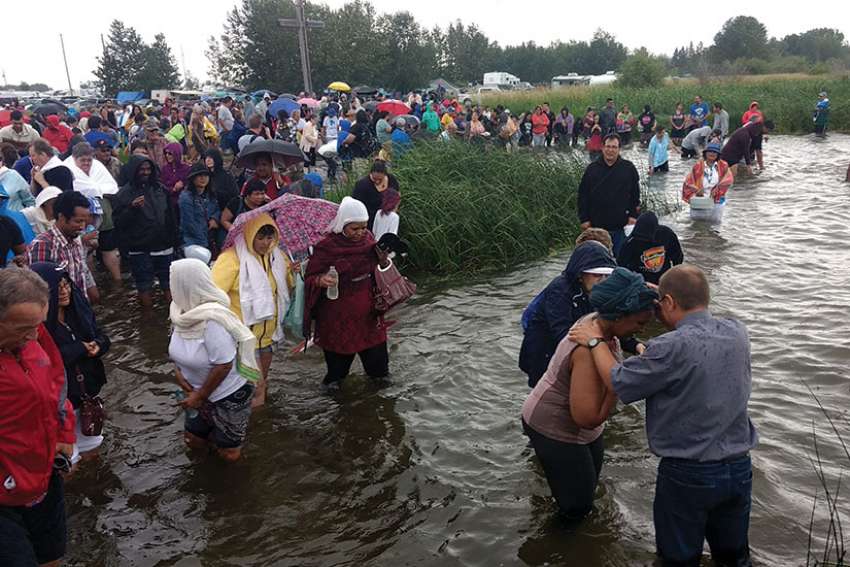“It’s a beautiful time and place to be with other Indigenous Catholics…. Every year is special,” said Stephanie Alexis, a member of the Alexis Nakota Sioux Nation and campsite co-ordinator for the pilgrimage to the site that has been the source of countless stories of healing and miracle cures.
“The lake is a healing place. A place to renew and rejuvenate your spirit and soul,” said Alexis.
This year’s gathering at the lake about 80 km west of Edmonton took place July 22-27. More than 9,000 people from near and far camp on the site for the duration of the pilgrimage and up to 30,000 pilgrims attend the week-long events, highlighted by the July 26 feast day of St. Anne, Mother of the Blessed Virgin Mary.
The program includes three daily eucharistic services hosted by local Aboriginal communities.
Lac Ste. Anne has always been considered a sacred site by Aboriginal people. Originally, it was called Wakamne, or God’s Lake, by the Nakota First Nations. The Cree referred to it as Spirit Lake.
A permanent mission was established in 1844 by Fr. Jean-Baptiste Thibault, an Oblate who renamed the site Lac Ste. Anne.
In 1889, the first annual pilgrimage was arranged by Fr. Joseph Lestanc, who was inspired by a visit to the St. Anne d’Aurey shrine in Brittany, France. In 2000, the Oblates proposed a partnership with the Aboriginal people to own, direct and operate the Lac Ste. Anne Pilgrimage under the LSA trust.
Fr. Garry LaBoucane, the pilgrimage’s spiritual director and a member of the Métis Nation of Alberta, took his first dip into the healing waters of the lake when he was just 10 months old. He was sick with the skin condition eczema at the time, he said, and his parents brought him to the lake for healing, with positive results.
His extended family has been attending the pilgrimage for generations — “since the days of horses and buggies,” he says.
LaBoucane says pilgrims to the lake will pray all day long.
“They spend their (summer) holidays in prayer. It’s quite a miracle, really,” he said.
Alexis has been involved with the pilgrimage for her entire life. “We have a tradition to walk and pray to the pilgrimage grounds from our reserve,” she said. “It’s a form of penance that our ancestors passed down to us.”
Visitors arrive on foot, by car, in RVs, or even on horseback. It’s an opportunity for Aboriginal and non-Aboriginal Catholics to gather together united by faith, even if the reasons for making the trek can vary greatly.
“Some of us come for healing and ask our Father for the grace to rejuvenate our soul,” said Alexis. “We come for penance and thanksgiving. We visit with our grandmother St. Anne and pray with her.
“In our Indigenous culture, grandmothers are our greatest teachers. Our grandmother St. Anne watches over us and she helps many come to know her grandson Jesus. I believe her spirit and love for her grandson attracts many. There’s a statue of her before the shrine and it just touches my heart to see her there and people going there non-stop to pray and honour her with rosaries and flowers.”


